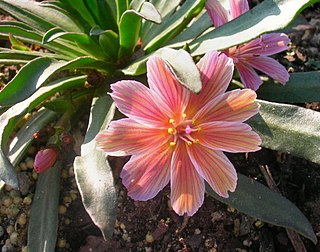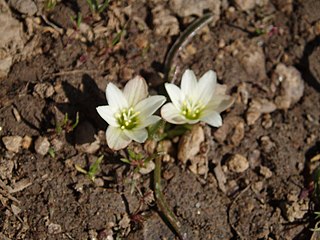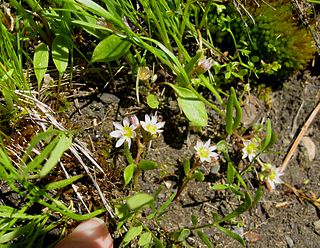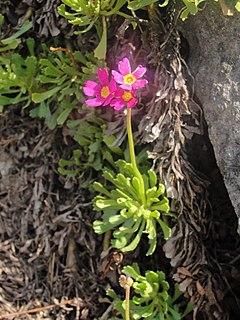
Lewisia is a plant genus, named for the American explorer Meriwether Lewis (1774-1809) who encountered the species in 1806. The native habitat of Lewisia species is north facing cliffs in western North America. Local Native Americans ate the roots, which have also been used to treat sore throats.

Dudleya verityi is a rare species of succulent plant known by the common name Verity's liveforever. It is endemic to Ventura County, California, where it is known from only three occurrences in the vicinity of Conejo Mountain between Camarillo and Thousand Oaks. It probably occurs in a few additional locations nearby which have not yet been officially vouchered.

Lewisia brachycalyx is a species of flowering plant in the family Montiaceae, known by the common name short-sepal bitter-root or shortsepal lewisia. It is native to the mountains of the southwestern United States and Baja California, where it grows in moist habitat such as meadows. It is a deciduous perennial growing from a short thick taproot and caudex unit. It produces a basal rosette of thick, fleshy, blunt-tipped narrow leaves up to 8 centimeters long. The inflorescence is under 4 centimeters tall, taking the form of a cluster of several flowers sitting atop the leaf rosette. Each flower has 5 to 9 shiny white or pink petals about 2 centimeters long. At the center are many stamens and stigmas clumped together. The Latin specific epithet brachycalyx means “having a short calyx”.

Lewisia cantelovii is an uncommon species of flowering plant in the family Montiaceae known by the common name Cantelow's lewisia. It is endemic to California, where it is known from the northeastern mountain ranges from the Klamath Mountains to the northern Sierra Nevada. It grows in rocky, moist mountain habitat. This is a perennial herb growing from a short, thick taproot and caudex unit. It produces a basal rosette of thick, fleshy, blunt-tipped spoon-shaped leaves with serrated edges. The inflorescence is a very slender erect stem up to 45 centimeters tall topped with a spreading panicle of flowers and glandular, toothed bracts. Each flower has 5 to 7 oval petals each one half to one centimeter long. The petals are white or very pale pink with sharp dark pink veins. At the center of the flower are five stamens tipped with dark pink anthers.

Lewisia columbiana, the Columbian lewisia, is a species of flowering plant in the family Montiaceae. It is native to the western United States and British Columbia, where it grows in rocky mountain habitats. This herbaceous perennial grows from a short, thick taproot and caudex unit. It produces a basal rosette of many thick, fleshy, tapering, blunt-tipped or pointed leaves with smooth edges, each 2 to 10 centimeters long. The inflorescence arises on several stems up to about 30 centimeters tall, each stem bearing an array of up to 100 flowers each. Near the flowers are small, pointed bracts tipped with shiny spherical resin glands. The flower has 4 to 11 petals, each up to about a centimeter in length and oval in shape with a notched tip. The petals are white to pale pink, usually with sharp dark pink veining.

Lewisia congdonii, known by the common name Congdon's lewisia, is a rare species of flowering plant in the family Montiaceae.

Lewisia cotyledon is a species of flowering plant in the family Montiaceae known by the common names Siskiyou lewisia and cliff maids. It is native to southern Oregon and northern California, where it grows in rocky subalpine mountain habitat.

Lewisia kelloggii is a species of flowering plant in the family Montiaceae known by the common name Kellogg's lewisia. It is endemic to the Sierra Nevada of California, where it is known from several sites high in the mountains. It grows in rocky mountain habitat in granite and slate substrates. This is a perennial herb growing from a thick, short taproot and caudex unit. It produces a basal rosette of many thick, leathery, spoon-shaped leaves up to 9 centimeters long. The inflorescence bears several flowers, each on a very short stalk. The flower has 5 to 13 shiny white or pinkish petals just over a centimeter long. Under the petals are two sepals and two similar bracts lined with spherical resin glands.

Lewisia leeana is a species of flowering plant in the family Montiaceae known by the common name quill-leaf lewisia. It is native to California and Oregon, where it grows in the mountains of the Sierra Nevada and Klamath Ranges. This is a perennial herb growing from narrow, woody taproot connected to one or more caudices. It produces a basal rosette of many fleshy flat to cylindrical blunt-tipped leaves up to 4 centimeters long. The inflorescence bears many flowers on erect, branching stems up to about 24 centimeters tall. Each flower has 5 to 8 white, pink, or purplish petals each about half a centimeter long.

Lewisia longipetala is a rare species of flowering plant in the family Montiaceae known by the common names long-petalled lewisia and Truckee lewisia. It is endemic to the Sierra Nevada of California, where it is known from less than 20 locations in areas not far from Lake Tahoe. It grows in subalpine and alpine climates in moist areas in rocky habitat, such as talus that retains patches of snow year-round. Most specimens grow on north-facing slopes with little surrounding vegetation. The plant thrives in the snow, growing largest and most densely in areas of high snowpack and becoming easily water-stressed when far away from areas with snow.

Lewisia nevadensis is a species of flowering plant in the family Montiaceae known by the common name Nevada lewisia. It is native to much of the western United States, where it grows in moist mountain habitat, such as meadows. This is a small perennial herb growing from a taproot and caudex unit. It produces a basal rosette of several narrow, fingerlike to threadlike fleshy leaves up to 13 centimeters long. The inflorescence is a bundle of short stems a few centimeters tall each bearing a flower. The flower has 5 to 10 shiny white to pale pink petals each 1 to 2 centimeters long, pointed or with blunt tips. At the center are many stamens. This is sometimes grown as an ornamental plant suitable for alpine and rock gardens.

Lewisia oppositifolia is a rare species of flowering plant in the family Montiaceae known by the common name opposite-leaf lewisia. It is native to the Klamath Mountains of Josephine County, Oregon, and Del Norte County, California, where it is a local serpentine endemic generally found in moist areas. This is a perennial herb growing from a small taproot and caudex unit. It produces a basal rosette of several lance-shaped, blunt-tipped fleshy leaves up to 11 centimeters long. There are sometimes smaller leaves located on the lower stem. The inflorescence is made up of one or more erect stems up to about 20 centimeters long, each bearing 1 to 6 flowers. The flower has 8 to 11 white to pale pink petals with blunt or jagged tips, each between 1 and 2 centimeters long. At the center are several stamens with pale anthers. This plant has a limited distribution and it is threatened by human activity in the area, such as logging.

Lewisia pygmaea is a species of flowering plant in the family Montiaceae known by the common name alpine lewisia and pygmy bitterroot. It is native to western North America from Alaska and Alberta to California and New Mexico, where it grows in many types of moist, rocky mountain habitat, such as gravel beds and sandy meadows. This is a highly variable species with a wide distribution, and it often hybridizes with other Lewisia species, making identification difficult. In general, this is a petite perennial herb growing from a taproot and caudex unit, and producing a basal rosette of several leaves 2 to 8 centimeters long. The leaves are narrow but thick and fleshy, blunt-tipped, and linear to lance-shaped. The inflorescence is usually made up of a few very short stems each bearing one or more flowers which appear to be sitting on or within the basal leaf rosette. Each flower has 5 to 9 white, pink or red petals which may or may not have dark veining or striping. The petals are 4 millimeters to 1 centimeter long.

Lewisia stebbinsii is a rare species of flowering plant in the family Montiaceae known by the common name Stebbins' lewisia. It is endemic to California, where it is known from less than fifteen sites in the Inner North Coast Ranges of Mendocino and Trinity Counties, mainly in Mendocino National Forest.

Lewisia triphylla is a species of flowering plant in the family Montiaceae known by the common name threeleaf lewisia. It is native to western North America from British Columbia to California to Colorado, where it grows in mountain and forest habitat, often in wet, rocky alpine areas where it may bloom through the snowmelt. This is a perennial herb growing from a fibrous taproot and corm unit. Instead of a basal rosette like many other Lewisia species it produces 2 to 5 short, slender, fleshy leaves from the lower part of the stem, which may be at or under the soil surface. The small stem bears an inflorescence of 1 to 25 flowers. The flower has 5 to 9 small white or pinkish petals often marked with darker veining or stripes.

Lewisiopsis tweedyi is a flowering plant and sole species in genus Lewisiopsis. The species, formerly known as Cistanthe tweedyi and Lewisia tweedyi, is now classified in the family Montiaceae. The plant is known by the common names Tweedy's pussypaws, Tweedy's lewisia, or Tweedy's bitterroot. It is endemic to western North America in north-central Washington and adjacent British Columbia. It commonly grows on well-drained slopes often on rocky slopes or in rock crevices from low elevation ponderosa pine sites up to the drier part of the Grand Fir zone of the North Cascades. The flowers usually have a coral, apricot, or pink color.

Nepenthes chang is a tropical pitcher plant endemic to the Banthad Mountains of central Thailand, where it grows at elevations of 300–600 m above sea level. It is thought to be most closely related to N. kampotiana.

Primula suffrutescens is a species of primrose known by the common name Sierra primrose.

The flora of the U.S. Sierra Nevada alpine zone is characterized by small, low growing, cushion and mat forming plants that can survive the harsh conditions in the high-altitude alpine zone above the timber line. These flora often occur in alpine fell-fields. The Sierra Nevada alpine zone lacks a dominant plant species that characterizes it, so may or may not be called a vegetation type. But it is found above the subalpine forest, which is the highest in a succession of recognized vegetation types at increasing elevations.

Dudleya rubens is a species of succulent perennial plant in the family Crassulaceae known by the common name as the San Francisco liveforever, native to the mountains of Baja California Sur. It is a rosette-forming plant with waxy leaves, characterized by branching stems and dull red to apricot flowers. It is only found above 500 metres (1,600 ft) in the Sierra de San Francisco and the Sierra de la Giganta ranges in Baja California Sur, primarily on north-facing volcanic slopes.





















